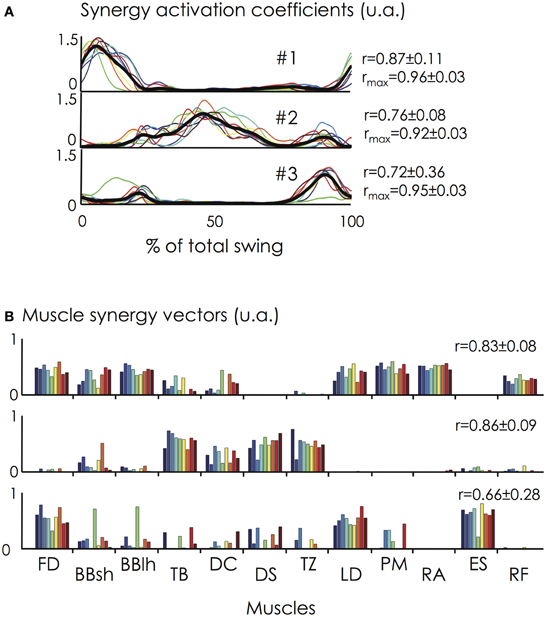
The community structure of the multiplex network revealed four modules, which clustered functional and anatomical linked muscles across modes of coordination. NMF of the coherence spectra distinguished three EMG frequency bands: 4–8, 8–22, and 22–60 Hz. The corresponding multiplex network contained a single module indicating pronounced muscle co-activation patterns across the whole body during a gait cycle. We found five relevant muscle synergies that significantly differed in activation patterns between 1:1 and 2:1 arm-leg coordination and the transition period between them. We decomposed EMG envelopes and intermuscular coherence spectra using non-negative matrix factorization (NMF), and the resulting modes were combined into multiplex networks and analyzed for their community structure. Walking speed was varied from very slow to normal. Subjects walked on a treadmill with their arms swinging along their body while kinematics and surface electromyography (EMG) of 26 bilateral muscles across the body were recorded. We examined whether these switches are accompanied by changes in functional connectivity between multiple muscles. When walking speed is increased, the frequency ratio between the arm and leg swing switches spontaneously from 2:1 to 1:1. 3Neuroscience Research Australia, Randwick, NSW, Australia.2Department of Neuropsychology and Psychopharmacology, Faculty of Psychology and Neuroscience, Maastricht University, Maastricht, Netherlands.1Department of Human Movement Sciences, Faculty of Behavioural and Movement Sciences, Amsterdam Movement Sciences & Institute for Brain and Behavior Amsterdam, Vrije Universiteit, Amsterdam, Netherlands.Boonstra 2,3, Andreas Daffertshofer 1* and Nadia Dominici 1 Feasibility of muscle synergy outcomes in clinics, robotics, and sports: a systematic review, Applied bionics and biomechanics, 2018.Jennifer N. The Effect of Signal-to-Noise Ratio on Muscle Synergy Extraction, In 2018 IEEE Life Sciences Conference (LSC), pp. Muscle synergies in patients with low back pain: A statistical gait analysis study pre-and post-rehabilitation, In 2018 IEEE International Symposium on Medical Measurements and Applications (MeMeA), pp. hdl:11583/2676666Īgostini V., Rimini D., Ghislieri M., Knaflitz M., Frola U., Trucco M. Influence of pre-processing in the extraction of muscle synergies during human locomotion, In 2017 39th Annual International Conference of the IEEE Engineering in Medicine and Biology Society (EMBC), pp. Rimini D., Agostini V., Rosati S., Castagneri C., Balestra G., Knaflitz M. Intra-subject consistency during locomotion: similarity in shared and subject-specific muscle synergies, Frontiers in human neuroscience, vol.

This can have important applications in clinics, robotics and sport science. This research line is focused on the assessment of the modular organization of the CNS during postural balance, locomotion or more complex motor tasks, both in physiological and pathological conditions, by means of muscle synergy extraction. According to this theory, the CNS control a small number of muscles rather than coordinating every single muscle that is involved in a specific motor task. In the last years, the muscle synergy theory was proposed for the assessment of the modular organization of the CNS during different motor tasks. The organization of the CNS in controlling and coordinating a large number of muscles during different motor tasks still represents an open issue in the field of motor control. The central nervous system (CNS) plays the main role in motor control since it activates each muscle choosing both the magnitude and the timing of the activation. Motor tasks are achieved by activating an appropriate set of muscles depending on the task constraints of a specific movement. Muscle Synergy extraction in human balance and motor control


 0 kommentar(er)
0 kommentar(er)
